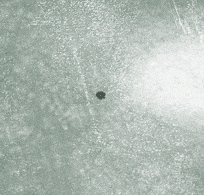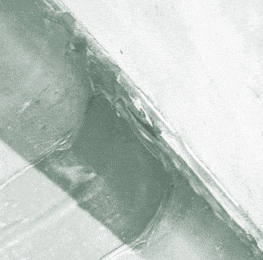Understanding and Inspecting EPDM Roofing, Part 1
EPDM (Ethylene Propylene Diene Monomer), or “rubber roofing,” is one type of single ply roofing. Since it first appeared in the mid 60s, EPDM has proven to be a reliable and durable roofing system. The material has the appearance and feel of a tire inner tube, and it rebounds when stretched. Although it is available in white and in black, black is most often used, probably due to a slightly better track record on performance. Neither color requires protection from ultraviolet rays.

Photo: This wet spot was a pin hole. Moisture in underlying substrate was being drawn out by the sun.
White membrane is typically used on buildings where there are concerns about thermal heat transfer or about sweating under the membrane. Black membrane can be painted white, but only with water-based acrylic paint. The white paint keeps the surface cooler to help minimize heat gain, and to help control condensation from forming under the membrane, which is sometimes a problem. White membrane, whether original or painted, can be as much as 80 degrees cooler than black, which can translate to significant energy savings in an air-conditioned building.

Photo: EPDM flashing at mechanical equipment with separation in membrane – actual leak.
EPDM membrane is available in several thicknesses (.045 and .060) and in reinforced versions. Re-inforced EPDM is most often used when there is a reason to be concerned about membrane fatigue or a higher than usual chance of puncture.
EPDM is installed in one of three ways. It can be loose laid and held down with ballast (rounded rocks); it can be mechanically fastened to the roof with bars and buttons; or it can be fully adhered to the deck.
The ballast system is often used over expanded polystyrene insulation, which is lightweight, economical and energy efficient. Because the EPDM adhesives dissolve the polystyrene, the membrane is only laid over the insulation, mechanically attached around the perimeters and held down with ballast (rocks). If the structure cannot support the additional weight of ballast, or if EPDM is being installed over existing roofing material, such as tar and gravel, a mechanical attached system is a better choice. Reinforced EPDM is recommended for mechanically attached applications because it is resistant to punctures/tears and wind fatigue at anchors. The fully adhered system is the most common, especially on residential buildings. Typically it has fewer problems than the other two applications.
The two primary manufactures of EPDM are Carlisle and Firestone, but the product is sold under many brand names. For example, Genflex, Mule-Hide, etc. are distributors of EPDM who have re-named either Carlisle or Firestone made EPDM.
Warranties vary ranging from 5 to 20 years, but seldom are offered for residential applications. The material is extremely durable, with little detectable wear in 25 to 30 years. The membrane will by far outlast asphalt-based products. Failures are typically in laps, flashing and around roof penetrations. The first EPDM roof was installed in 1965, and reports indicate it is still performing today!
Getting the most out of EPDM
EPDM membrane cannot be directly applied or be in contact with any product containing coal tar pitch, creosote or penta-based materials. Contaminants such as petroleum grease, acid, solvents, vegetable or mineral oils and animal oils or fats will soften and degrade the membrane.
Asphalt based roof cements or mastics cannot be used as a patch. Direct steam venting can also cause degradation and should be avoided. Standing water or wet leaves have no adverse effect on the membrane. In fact, EPDM has been used for pond liners for years. Nevertheless, ponding should not be allowed on any flat roof.
In other words, water should not remain on a roof 48 hours after precipitation. Manu-facturers of EPDM recommend a positive drainage system (1/4″ per foot). Over time ponding can exceed structural design weight allowances. Also freezing over seams can apply stress that may lead to seam failure.
Two common problems
EPDM has outstanding durability, but there have been some problems. The two most common are shrinkage and lap failures.
The membrane is prone to shrinkage (1-2 percent). On a large roof this can add up to several feet of shrinkage, which causes bridging and/or failures at flashing and terminations. Typically, this problem only occurs on a large building with a “ballast” system, and generally only if it was not anchored properly at the roof perimeters and/or walls. A shrinkage problem is rare on a fully adhered system or on a residential property. The cause of the membrane shrinkage has been link to one or a combination of the following factors:
- loss of processing oils,
- residual stresses from the manufacturing process, and/or
- failure to allow the membrane to relax prior to installing.
Prior to 1986 EPDM lap splice cements were made with a neoprene polymer and laps occasionally failed. Newer lap splice cements are butyl polymer and are more reliable. Problems were also reported with the early uncured neoprene rubber used as flashing material. Uncured neoprene rubber was used as flashing because of its moldable (tacky) characteristics. Unfortunately it had a short life span, and it was known to fail after becoming brittle.
New technology (uncured) EPDM was then introduced. Often called “Peel and Stick,” uncured EPDM also is a tacky, moldable membrane, but it is known to be reliable. The most recent recommendation is to use uncured EPDM for only the most difficult moldable type applications, such as corners and penetrations. Cured EPDM is recommended for all other applications.
Inspecting EPDM
Inspecting an EPDM membrane roof is much like inspecting any flat roof. Identifying the single-ply can be tricky. It’s easy to confuse EPDM and PVC. PVC feels slicker and firmer than EPDM, much like a vinyl pool liner, and the seams are typically welded (heat melted) together. Of course there are other types of single ply membranes, but EPDM and PVC are the two most likely to be confused on a single-family home. If you are not sure what it is, you may be better off calling it a single-ply membrane. Because EPDM does not age like typical asphalt-based roofing, it can be difficult to report how old it is. Some manufacturers date EPDM membrane with a stamp, which takes away the mystery. But most of the time, it comes down to an estimated guess.
To Read the Full Article
ASHI offers its members unparalleled resources to advance their careers. ASHI offers training for inspectors at all levels of knowledge and experience, including resources about all major home systems. Members benefit from a vast network of experienced professionals, providing a community for mentorship and knowledge sharing..
In this Issue

FIND A HOME
INSPECTOR
Professional Networking
Grow your professional network, find a mentor, network with the best, and best part of the community that’s making home inspection better every day.
